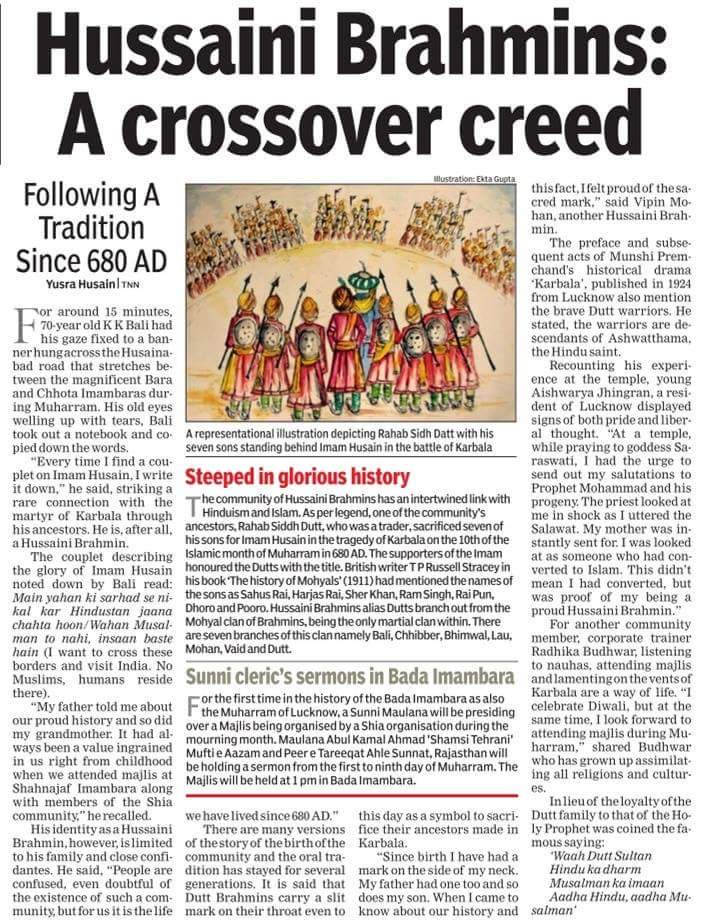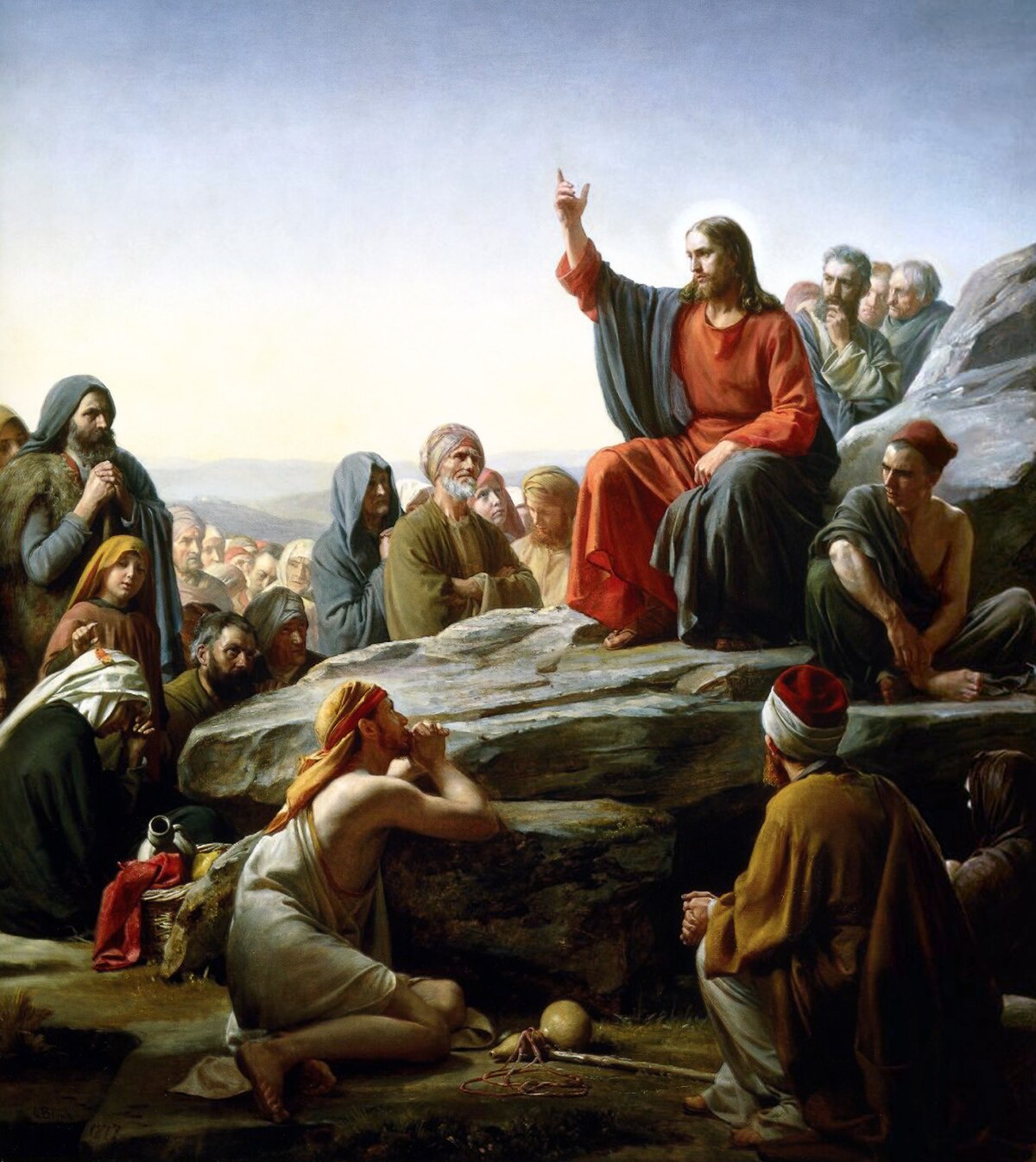INDIAPOSITIVE
ELITE MEMBER

- Joined
- Sep 20, 2014
- Messages
- 9,318
- Reaction score
- -28
- Country
- Location
The community of Hussaini Brahmins is not well known in the country. They are Hindus but also have faith in Imam Hussain, the grandson of Prophet Mohammad. They pay obeisance to the Hindu idols and photographs but also keep the ‘Alam’ – the standard with the emblem of Imam Hussain in the Pooja corner of their houses.
Hussaini Brahmin is a Mohyal Brahmin community in the Punjab region. The Mohyal community comprises seven sub-clans named Bali, Bhimwal, Chhibber, Dutt, Lau, Mohan, and Vaid. Mohyal Brahmin of the Dutt clan had fought on behalf of Imam Hussain in the Battle of Karbala (680 C.E.)
According to legend, Rahab Sidh Dutt was the leader of a small band of career soldiers living near Baghdad around the time of the battle of Karbala. The legend mentions the place where he stayed as Dair-al-Hindiya, meaning “The Indian Quarter”, which matches with Al-Hindiya a place that exists even today.
As consistent with the Hindu tradition, the Moyhal community adopted non-Indic traditions which led to the emergence of a small sub-sect of Hussaini Brahman paying reverence to Islam, most notably to Imam Hussain. As a result, many Hussaini Brahmin observes Muharram every year even to this date.
According to historical records, about 1,400 Brahmins were living in Baghdad capital of Iraq when the Battle of Karbala took place. Few families are still found in parts of Iraq, but most are now settled in Pune, Delhi, Chandigarh, Amritsar, and Jammu in India, Sindh, and Lahore in Pakistan, and Kabul in South Afghanistan.
Until the Partition of India, many Hussaini Brahmins used to live in Lahore. In Ajmer, there is a small group of people who calls themselves Hussaini Brahmins even today. In Bihar, a sect of Bhumihar Brahmins in the Muzzafarpur district also claims ancestry from Hussaini Brahmins.
Hussaini Brahmins are neither ‘orthodox Hindus’ nor orthodox Muslims. They practice a blend of orthodox Vedic and Islamic traditions. A saying in Hindi/Urdu refers to the Hussaini Brahmans as: “Wah Datt Sultan, Hindu ka dharm, Musalman ka Iman, Adha Hindu adha Musalman” (Well Datt Sultan, declaring Hindu Dharma and following Muslim practice, Half Hindu and Half Muslim.
Some prominent personalities of the Hussaini Brahmin community are; actor Sunil Dutt, Urdu writers Kashmiri Lal Zakir, Sabir Dutt, and Nand Kishore Vikram.
The Hussaini Brahmins community follows all the traditions observed by the Shia sect of Muslims during the month of Muharram. They offer salutations in the Azakhan’, the place where Muharram azadari is held. Many are well versed in the technique of reading Marsiya, Nauha and Salaam (elegies lamenting the death of martyrs in the Battle of Karbala).
Most of the Hussaini Brahmins are born in a Saraswat Hindu family. They carry forward the tradition of the belief in Imam Hussain that they have learned from their forefathers. They attend Majlis and recite elegies during the days of mourning in Muharram.
Sunita Jhingran, a renowned classical music singer best known for her thumri, khayal, dadra and ghazal, is a Hussaini Brahmin who says; “God made humans first but we divided ourselves into religions. The blood in the bodies of both the Hindus and the Muslims is red. We must understand that humanity is the greatest of all religions and this is my way of promoting love and respect for all.”
She adds, “For me, religion is a personal affair between God and me and no one has the right to tell me who I am.” She laid stress on the need to understand the meaning of communal harmony to live in India. In this video, she explains the Hussaini Brahmin community that has tenets of both Hinduism and Islam.

@Raj-Hindustani
Hussaini Brahmin is a Mohyal Brahmin community in the Punjab region. The Mohyal community comprises seven sub-clans named Bali, Bhimwal, Chhibber, Dutt, Lau, Mohan, and Vaid. Mohyal Brahmin of the Dutt clan had fought on behalf of Imam Hussain in the Battle of Karbala (680 C.E.)
According to legend, Rahab Sidh Dutt was the leader of a small band of career soldiers living near Baghdad around the time of the battle of Karbala. The legend mentions the place where he stayed as Dair-al-Hindiya, meaning “The Indian Quarter”, which matches with Al-Hindiya a place that exists even today.
As consistent with the Hindu tradition, the Moyhal community adopted non-Indic traditions which led to the emergence of a small sub-sect of Hussaini Brahman paying reverence to Islam, most notably to Imam Hussain. As a result, many Hussaini Brahmin observes Muharram every year even to this date.
According to historical records, about 1,400 Brahmins were living in Baghdad capital of Iraq when the Battle of Karbala took place. Few families are still found in parts of Iraq, but most are now settled in Pune, Delhi, Chandigarh, Amritsar, and Jammu in India, Sindh, and Lahore in Pakistan, and Kabul in South Afghanistan.
Until the Partition of India, many Hussaini Brahmins used to live in Lahore. In Ajmer, there is a small group of people who calls themselves Hussaini Brahmins even today. In Bihar, a sect of Bhumihar Brahmins in the Muzzafarpur district also claims ancestry from Hussaini Brahmins.
Hussaini Brahmins are neither ‘orthodox Hindus’ nor orthodox Muslims. They practice a blend of orthodox Vedic and Islamic traditions. A saying in Hindi/Urdu refers to the Hussaini Brahmans as: “Wah Datt Sultan, Hindu ka dharm, Musalman ka Iman, Adha Hindu adha Musalman” (Well Datt Sultan, declaring Hindu Dharma and following Muslim practice, Half Hindu and Half Muslim.
Some prominent personalities of the Hussaini Brahmin community are; actor Sunil Dutt, Urdu writers Kashmiri Lal Zakir, Sabir Dutt, and Nand Kishore Vikram.
The Hussaini Brahmins community follows all the traditions observed by the Shia sect of Muslims during the month of Muharram. They offer salutations in the Azakhan’, the place where Muharram azadari is held. Many are well versed in the technique of reading Marsiya, Nauha and Salaam (elegies lamenting the death of martyrs in the Battle of Karbala).
Most of the Hussaini Brahmins are born in a Saraswat Hindu family. They carry forward the tradition of the belief in Imam Hussain that they have learned from their forefathers. They attend Majlis and recite elegies during the days of mourning in Muharram.
Sunita Jhingran, a renowned classical music singer best known for her thumri, khayal, dadra and ghazal, is a Hussaini Brahmin who says; “God made humans first but we divided ourselves into religions. The blood in the bodies of both the Hindus and the Muslims is red. We must understand that humanity is the greatest of all religions and this is my way of promoting love and respect for all.”
She adds, “For me, religion is a personal affair between God and me and no one has the right to tell me who I am.” She laid stress on the need to understand the meaning of communal harmony to live in India. In this video, she explains the Hussaini Brahmin community that has tenets of both Hinduism and Islam.

@Raj-Hindustani









